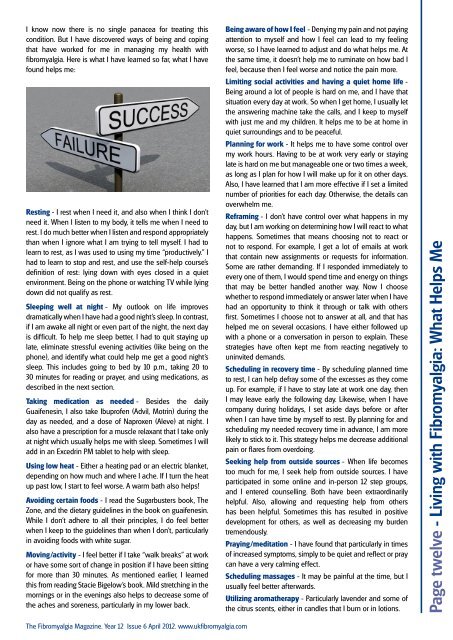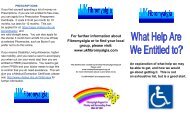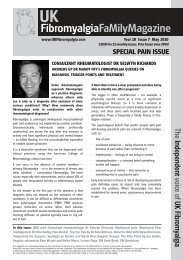to see a FREE copy of Fibromyalgia Magazine - UK Fibromyalgia
to see a FREE copy of Fibromyalgia Magazine - UK Fibromyalgia
to see a FREE copy of Fibromyalgia Magazine - UK Fibromyalgia
You also want an ePaper? Increase the reach of your titles
YUMPU automatically turns print PDFs into web optimized ePapers that Google loves.
I know now there is no single panacea for treating thiscondition. But I have discovered ways <strong>of</strong> being and copingthat have worked for me in managing my health withfibromyalgia. Here is what I have learned so far, what I havefound helps me:Resting - I rest when I need it, and also when I think I don’tneed it. When I listen <strong>to</strong> my body, it tells me when I need <strong>to</strong>rest. I do much better when I listen and respond appropriatelythan when I ignore what I am trying <strong>to</strong> tell myself. I had <strong>to</strong>learn <strong>to</strong> rest, as I was used <strong>to</strong> using my time “productively.” Ihad <strong>to</strong> learn <strong>to</strong> s<strong>to</strong>p and rest, and use the self-help course’sdefinition <strong>of</strong> rest: lying down with eyes closed in a quietenvironment. Being on the phone or watching TV while lyingdown did not qualify as rest.Sleeping well at night - My outlook on life improvesdramatically when I have had a good night’s sleep. In contrast,if I am awake all night or even part <strong>of</strong> the night, the next dayis difficult. To help me sleep better, I had <strong>to</strong> quit staying uplate, eliminate stressful evening activities (like being on thephone), and identify what could help me get a good night’ssleep. This includes going <strong>to</strong> bed by 10 p.m., taking 20 <strong>to</strong>30 minutes for reading or prayer, and using medications, asdescribed in the next section.Taking medication as needed - Besides the dailyGuaifenesin, I also take Ibupr<strong>of</strong>en (Advil, Motrin) during theday as needed, and a dose <strong>of</strong> Naproxen (Aleve) at night. Ialso have a prescription for a muscle relaxant that I take onlyat night which usually helps me with sleep. Sometimes I willadd in an Excedrin PM tablet <strong>to</strong> help with sleep.Using low heat - Either a heating pad or an electric blanket,depending on how much and where I ache. If I turn the heatup past low, I start <strong>to</strong> feel worse. A warm bath also helps!Avoiding certain foods - I read the Sugarbusters book, TheZone, and the dietary guidelines in the book on guaifenesin.While I don’t adhere <strong>to</strong> all their principles, I do feel betterwhen I keep <strong>to</strong> the guidelines than when I don’t, particularlyin avoiding foods with white sugar.Moving/activity - I feel better if I take “walk breaks” at workor have some sort <strong>of</strong> change in position if I have been sittingfor more than 30 minutes. As mentioned earlier, I learnedthis from reading Stacie Bigelow’s book. Mild stretching in themornings or in the evenings also helps <strong>to</strong> decrease some <strong>of</strong>the aches and soreness, particularly in my lower back.Being aware <strong>of</strong> how I feel - Denying my pain and not payingattention <strong>to</strong> myself and how I feel can lead <strong>to</strong> my feelingworse, so I have learned <strong>to</strong> adjust and do what helps me. Atthe same time, it doesn’t help me <strong>to</strong> ruminate on how bad Ifeel, because then I feel worse and notice the pain more.Limiting social activities and having a quiet home life -Being around a lot <strong>of</strong> people is hard on me, and I have thatsituation every day at work. So when I get home, I usually letthe answering machine take the calls, and I keep <strong>to</strong> myselfwith just me and my children. It helps me <strong>to</strong> be at home inquiet surroundings and <strong>to</strong> be peaceful.Planning for work - It helps me <strong>to</strong> have some control overmy work hours. Having <strong>to</strong> be at work very early or stayinglate is hard on me but manageable one or two times a week,as long as I plan for how I will make up for it on other days.Also, I have learned that I am more effective if I set a limitednumber <strong>of</strong> priorities for each day. Otherwise, the details canoverwhelm me.Reframing - I don’t have control over what happens in myday, but I am working on determining how I will react <strong>to</strong> whathappens. Sometimes that means choosing not <strong>to</strong> react ornot <strong>to</strong> respond. For example, I get a lot <strong>of</strong> emails at workthat contain new assignments or requests for information.Some are rather demanding. If I responded immediately <strong>to</strong>every one <strong>of</strong> them, I would spend time and energy on thingsthat may be better handled another way. Now I choosewhether <strong>to</strong> respond immediately or answer later when I havehad an opportunity <strong>to</strong> think it through or talk with othersfirst. Sometimes I choose not <strong>to</strong> answer at all, and that hashelped me on several occasions. I have either followed upwith a phone or a conversation in person <strong>to</strong> explain. Thesestrategies have <strong>of</strong>ten kept me from reacting negatively <strong>to</strong>uninvited demands.Scheduling in recovery time - By scheduling planned time<strong>to</strong> rest, I can help defray some <strong>of</strong> the excesses as they comeup. For example, if I have <strong>to</strong> stay late at work one day, thenI may leave early the following day. Likewise, when I havecompany during holidays, I set aside days before or afterwhen I can have time by myself <strong>to</strong> rest. By planning for andscheduling my needed recovery time in advance, I am morelikely <strong>to</strong> stick <strong>to</strong> it. This strategy helps me decrease additionalpain or flares from overdoing.Seeking help from outside sources - When life becomes<strong>to</strong>o much for me, I <strong>see</strong>k help from outside sources. I haveparticipated in some online and in-person 12 step groups,and I entered counselling. Both have been extraordinarilyhelpful. Also, allowing and requesting help from othershas been helpful. Sometimes this has resulted in positivedevelopment for others, as well as decreasing my burdentremendously.Praying/meditation - I have found that particularly in times<strong>of</strong> increased symp<strong>to</strong>ms, simply <strong>to</strong> be quiet and reflect or praycan have a very calming effect.Scheduling massages - It may be painful at the time, but Iusually feel better afterwards.Utilizing aromatherapy - Particularly lavender and some <strong>of</strong>the citrus scents, either in candles that I burn or in lotions.Page twelve - Living with <strong>Fibromyalgia</strong>: What Helps MeThe <strong>Fibromyalgia</strong> <strong>Magazine</strong>. Year 12 Issue 6 April 2012. www.ukfibromyalgia.com





